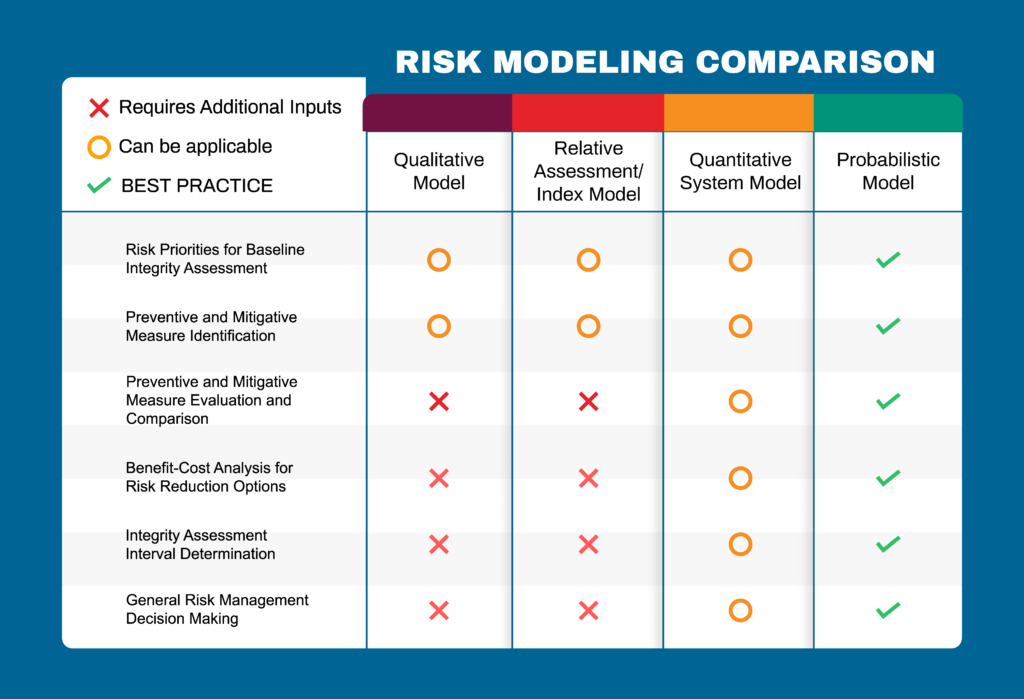On the back of the Mega Gas Rule, PHMSA and the US Department of Transportation assessed the suitability of different risk models based on the capability of each model to support required risk management decisions. As a result, Probabilistic models have been deemed the only Best Practice model for supporting all decision types.
Why Is Probabilistic Modeling Best Practice?
Probabilistic Risk Assessment (PRA) is a quantitative methodology that analyzes larger datasets in a risk framework and can provide an output in the context of probability, such as expected product loss or frequency of occurrence presented in failures per unit time. These allow operators to understand and assess their threats and strategies in greater depth.
PHMSA reports that PRA “provides the likelihood of individual risk factors…combining these likelihoods according to the logical relationships in the model.”[1] It provides a big step forward from the more limited, qualitative models and can help decision-makers as they seek to address their asset risks on their own terms, as they become the “drivers” of their model.
As a result, a PRA model provides accurate insights into the future of pipeline assets and provides deeper information that allows smart, informed business decisions, while providing consistency year-on-year.
Simplified Data Interpretation
Datasets in this industry are large and it is impossible to keep singularities in mind as you scan across the various threats. ENERCON has built a PRA modeling software that can work all the calculations and provide summary distributions of risk, such as the probability of failure x the consequence of failure. It then distills the information down in a manner that allows the user to see risk and evaluate it at a summary level, no matter how big the enterprise or pipeline system may be.
PHMSA has stated that the overriding principle of employing a model to support risk assessment is that it be capable of supporting risk decisions. The ENERCON PRA model does just that. Your decisions stand on an empirical foundation that has removed internal politics and subjectivity from the equations resulting in an objective view of the real threats. This view provides decision-makers clear sight of how to use existing resources to reduce that risk and provides a bit of security to the state and federal regulators charged with oversight of your operation. They can see your logic and rely on your results which yields a high degree of comfort that they will not be second-guessing your risk decisions or telling you how to spend your resources. In the end, PRA keeps you in control and behind the wheel as you navigate both business challenges and regulatory constraints.
Where Qualitative Models Fail
Most pipeline companies implement “Qualitative Risk Assessment” methodologies, which are based not on data, but on general rules of thumb and operator experience. Risks are categorized as Green-Yellow-Red, in an attempt to try to grasp where their assets are impacted or threatened.
“Both the Department of Transportation’s PHMSA and the National Transportation Safety Board (NTSB) has identified general weaknesses in the risk models used by pipeline operators in performing risk assessments for their IM programs,” according to a 2020 Pipeline Risk Modeling report put out by US Department of Transportation in 2020.
With a Qualitative Risk Assessment, a threat may be mapped to the middle or “yellow” category, which is ambiguous & non-specific. A Quantitative model, while a Relative Risk Assessment may be able to tell you that the same threat is the second-highest relative risk for that threat category, which is quite significant, and allow the operator to prioritize this risk in relation to other risks across their assets.
ENERCON’s PRA model draws from decades of experience in risk-informed decision making and PRA implementation. The foundation provided from our PRA model can lead organizations to implement sound, data-driven strategies across their fleet.
[1] Pipeline Risk Modeling, Overview of Methods and Tools for Improved Implementation, PHMSA, 2/1/2020


